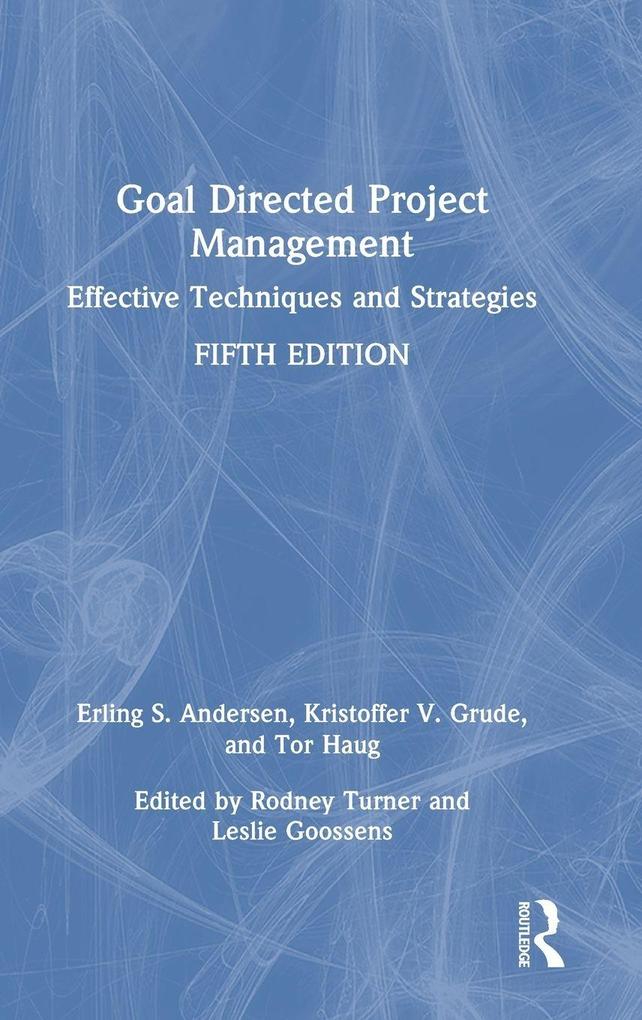Bücher versandkostenfrei*100 Tage RückgaberechtAbholung in der Wunschfiliale
10% Rabatt10 auf Toniebox 1, Figuren & Zubehör mit dem Gutscheincode: TONIE10
Jetzt einlösen
mehr erfahren
Zustellung: Do, 13.11. - Mo, 17.11.
Noch nicht erschienen
VersandkostenfreiBestellen & in Filiale abholen:
Goal Directed Project Management (GDPM) is a method developed by the authors, based on practical experience. It has been refined over 40 years and is still widespread in curricula in universities/colleges and adopted as a standard approach by organisations all over the world.
The book is different from other textbooks in project management as it is a focused approach on how to do it, rather than a general discussion. The book emphasises PSO (People, System, and Organisational development), the need to develop People (training and motivation) and Organisation in conjunction with Systems/technical development if you want desired results. The book presents detailed and practical guidance on how to plan, organise, and control PSO projects through hierarchical planning with practical methods and tools (milestone and activity planning and responsibility charts). Uncertainty and multi¿project management are also covered.
New in this edition is benefit realisation. Most of the work on benefit realisation takes place after a project has been delivered, but a lot can be implemented within the framework of the project. Research shows that the greatest degree of project success is achieved when there is a close relationship between benefit realisation and project management, and between project owner and project manager.
The book is different from other textbooks in project management as it is a focused approach on how to do it, rather than a general discussion. The book emphasises PSO (People, System, and Organisational development), the need to develop People (training and motivation) and Organisation in conjunction with Systems/technical development if you want desired results. The book presents detailed and practical guidance on how to plan, organise, and control PSO projects through hierarchical planning with practical methods and tools (milestone and activity planning and responsibility charts). Uncertainty and multi¿project management are also covered.
New in this edition is benefit realisation. Most of the work on benefit realisation takes place after a project has been delivered, but a lot can be implemented within the framework of the project. Research shows that the greatest degree of project success is achieved when there is a close relationship between benefit realisation and project management, and between project owner and project manager.
Inhaltsverzeichnis
1 Introduction 1.1 Themes and outline of the book 1.2 PSO project 1.3 Goal Directed Project Management (GDPM) 2 Characteristic features of a project 2.1 A unique task 2.2 Should lead to a specific result 2.3 Resource requirements 2.4 Time limit 2.5 Project management 3 Pitfalls 3.1 Cracks in the foundation 3.2 Pitfalls in planning 3.3 Pitfalls in organising 3.4 Pitfalls in controlling a project 3.5 Pitfalls in execution of project work 3.6 Pitfalls in benefit realisation 3.7 How to avoid the pitfalls - some considerations 4 The foundation of the project 4.1 Division of roles in project work - the principle responsibility chart 4.2 Purpose of the project and project goals 4.3 Purpose structure 4.4 Stakeholders and stakeholder analysis 4.5 Project mandate 5 Project benefits 5.1 The concepts of profit, benefit, and cost 5.2 Benefit/cost analysis 5.3 The work tasks related to the project's benefit realisation 5.4 Are we ready to see all the possibilities? 6 The decision criterion for project start¿up and examples of start¿up documents 6.1 Decision criterion when establishing the project 6.2 The 'Good physical working environment' project - project mandate and benefit realisation plan 7 Global planning - milestone planning 7.1 Principles of planning 7.2 Division of a project 7.3 Practical milestone planning 8 Global organising - milestone responsibility chart 8.1 Principles of project organising 8.2 Responsibility chart 8.3 Milestone responsibility chart 8.4 Time scheduling and resource estimation 8.5 Uncertainty in the project 8.6 Project budget 9 Detailed planning and detailed organising 9.1 Principles of project activity planning 9.2 Activity planning 9.3 Activity budgeting 10 Project control 10.1 What is control? 10.2 Principles of project control 10.3 Control at activity level working environment' project 10.4 Control at milestone level 10.5 Financial reporting and control 10.6 Project¿based learning 11 Quality in project work 11.1 The significance of quality projects for the benefit of the base organisation 11.2 Procedures to increase quality 11.3 Quality of the planning documents 12 The organisation's project culture 12.1 A good project culture 12.2 Top management 12.3 Line management 12.4 Project owner 12.5 The steering committee 12.6 The project manager 12.7 The employee representatives 12.8 A projectivity programme 13 Goal Directed Project Management - example and summary 13.1 Forms 13.2 IT support 13.3 Example project 'New possibilities in new premises' 13.4 Has the requirement specification been fulfilled? 13.5 A few final words 14 Goal Directed Project Management in a multi¿project environment 14.1 Use of projects to meet challenges 14.2 The concepts of project, project programme, and project portfolio 14.3 Programme management 14.4 Portfolio management 14.5 Support system for a multi¿project environment 15 Sources and supplementary literature
Produktdetails
Erscheinungsdatum
31. Oktober 2025
Sprache
englisch
Auflage
5. Auflage
Seitenanzahl
268
Autor/Autorin
Erling S. Andersen, Kristoffer V. Grude, Tor Haug
Verlag/Hersteller
Produktart
gebunden
Gewicht
453 g
ISBN
9781032994666
Entdecken Sie mehr
Bewertungen
0 Bewertungen
Es wurden noch keine Bewertungen abgegeben. Schreiben Sie die erste Bewertung zu "Goal Directed Project Management" und helfen Sie damit anderen bei der Kaufentscheidung.









